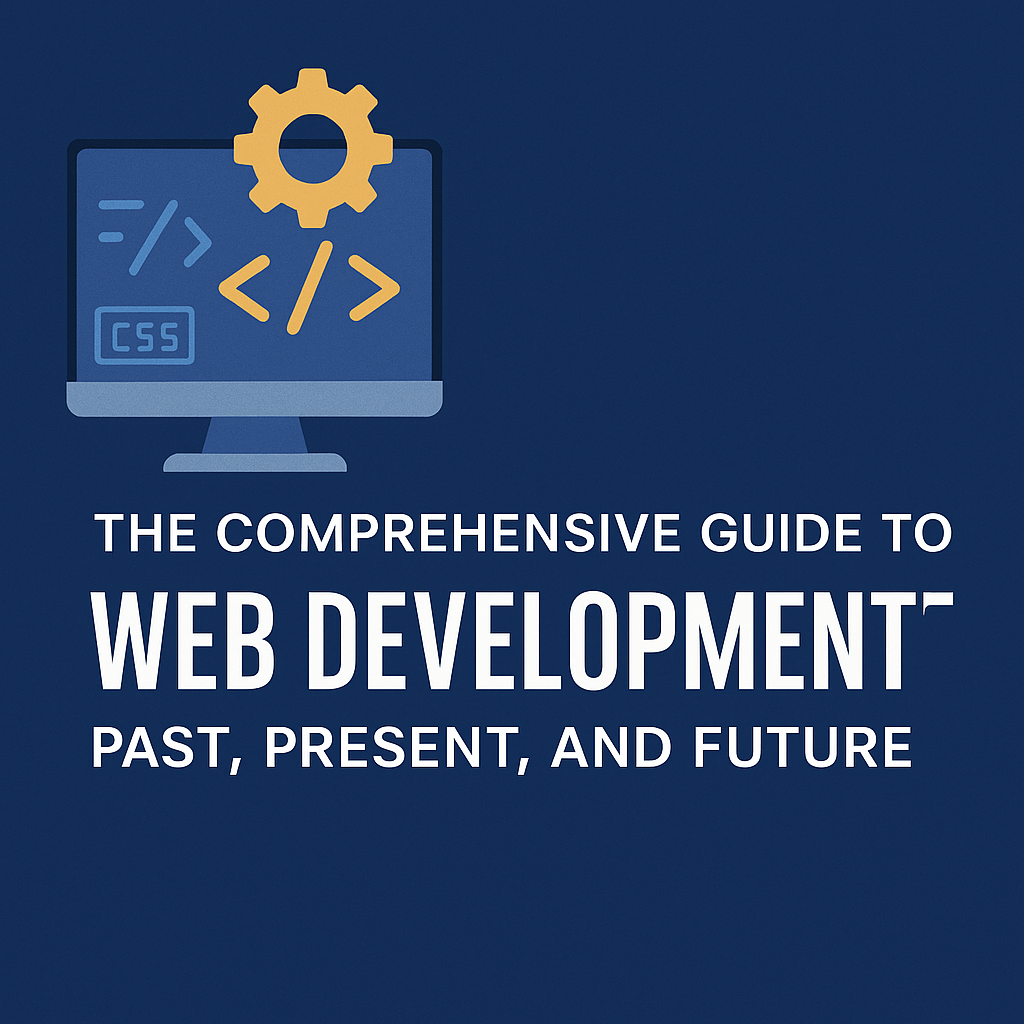Web development is one of the most transformative forces in the modern digital world. From static HTML pages in the 1990s to today’s sophisticated full-stack applications and AI-driven websites, the evolution of web development reflects broader technological, social, and economic changes. In this comprehensive blog, we will explore the journey of web development, core technologies, current trends, and what the future might look like.

1. What is Web Development?
Web development is the process of building and maintaining websites and web applications that run on a browser. It includes:
- Frontend Development: The visual part users interact with.
- Backend Development: The server-side logic, databases, and APIs.
- Full-Stack Development: A combination of both frontend and backend.
It involves everything from user interface design to server-side programming and database management.
2. The Evolution of Web Development
The Early Days (1990s – Early 2000s)
- HTML was the primary markup language.
- Websites were static, slow, and had minimal styling.
- JavaScript and CSS slowly introduced interactivity and better visuals.
- Netscape and Internet Explorer dominated the browser market.
Web 2.0 Era (Mid 2000s – 2010s)
- Rise of user-generated content (e.g., blogs, forums, social media).
- AJAX enabled dynamic content without full page reloads.
- Web applications like Gmail and Facebook reshaped user expectations.
Modern Web (2010s – Present)
- Single Page Applications (SPAs) became the norm.
- Frameworks like React, Angular, and Vue revolutionized frontend development.
- APIs, cloud hosting, and responsive design became standard.
3. Core Technologies in Web Development
Frontend (Client-side)
- HTML5 – Defines structure.
- CSS3 – Handles styling and layout.
- JavaScript – Adds logic and interactivity.
- Frameworks/Libraries: React.js, Angular, Vue.js
- Tools: Git, Webpack, Babel, Vite
Backend (Server-side)
- Languages: Node.js, Python, PHP, Ruby, Java
- Frameworks: Express.js, Django, Laravel, Flask
- Databases: MySQL, PostgreSQL, MongoDB, Firebase
- API Architectures: REST, GraphQL
- Authentication: JWT, OAuth
- Servers: Apache, Nginx
Full-Stack Combinations
- MERN: MongoDB, Express, React, Node
- LAMP: Linux, Apache, MySQL, PHP
- JAMstack: JavaScript, APIs, Markup
4. The Importance of Web Development Today
- Every business needs an online presence.
- E-commerce platforms power a global digital economy.
- Web apps enhance productivity (e.g., Google Docs, Trello).
- Online education and communities depend on the web.
- News, entertainment, and services are delivered via websites.
5. Modern Trends in Web Development (2025)
a. Jamstack Architecture
- Separates frontend from backend using APIs and pre-rendered markup.
- Improves speed and scalability.
- Tools: Gatsby, Next.js
b. Serverless Architecture
- Developers write functions without managing infrastructure.
- Examples: AWS Lambda, Netlify Functions
c. Headless CMS
- Backend content management without a fixed frontend.
- Tools: Contentful, Strapi, Sanity
d. AI and Machine Learning Integration
- Smarter apps using voice search, recommendations, chatbots.
- Libraries: TensorFlow.js, OpenAI
e. Progressive Web Apps (PWAs)
- Combine features of mobile and web apps.
- Offline support, push notifications, installability.
f. WebAssembly (Wasm)
- High-performance web apps using C++, Rust, etc.
- Used in gaming, video editing, and more.
g. Real-Time Web Apps
- Instant messaging, live notifications, collaboration tools.
- Technologies: Firebase, WebSockets, Socket.io
h. Accessibility and Dark Mode
- Enhanced UX for all users, including those with disabilities.
- Focus on contrast, ARIA tags, keyboard navigation.
6. Essential Skills for Web Developers
- HTML, CSS, and JavaScript fundamentals
- Responsive design and mobile-first principles
- Git and version control workflows
- Working with APIs and databases
- Familiarity with cloud platforms (Netlify, Firebase, AWS)
- Debugging and testing (Jest, Cypress)
- SEO basics and performance optimization
- Soft skills: communication, problem-solving, adaptability
7. Popular Tools and Platforms
- Code Editors: VS Code, Sublime Text
- Version Control: Git, GitHub, GitLab
- Hosting & Deployment: Netlify, Vercel, Heroku, Firebase
- Design & Prototyping: Figma, Adobe XD, Sketch
- Project Management: Trello, Jira, Notion
- CMS Options: WordPress, Ghost, Sanity, Contentful
8. Challenges in Web Development
- Browser compatibility across Chrome, Safari, Firefox, Edge
- Cybersecurity threats: XSS, CSRF, SQL Injection
- Site performance and speed optimization
- Constantly evolving technologies and frameworks
- Ensuring accessibility and user-friendly UX/UI
9. The Future of Web Development
AI-Powered Development
- Tools like GitHub Copilot and ChatGPT are assisting with code writing and debugging.
Low-Code/No-Code Platforms
- Empower non-coders to build apps and websites visually.
- Examples: Webflow, Bubble
Web3 and Decentralization
- Blockchain, dApps, and smart contracts are reshaping ownership and identity online.
Metaverse and WebXR
- Immersive 3D web experiences using VR/AR technologies.
Quantum-Safe Encryption
- Prepares for the post-quantum internet with secure algorithms.
Leave a Reply